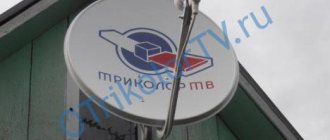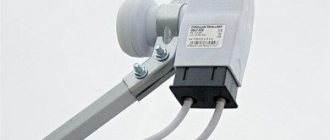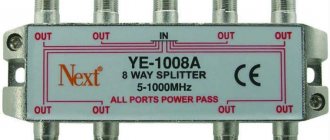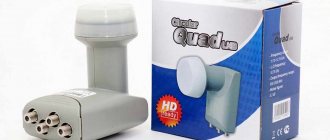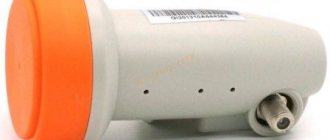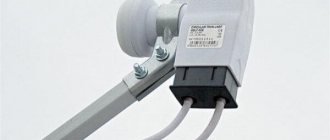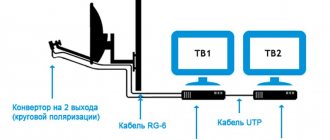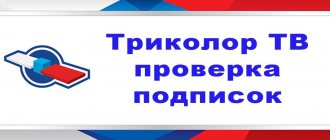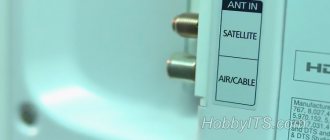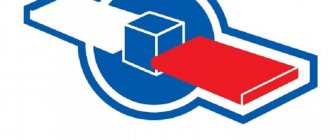Satellite television is a frequent guest in almost every home today. It is very convenient to use both in a city apartment and in a country house, where a satellite TV set is simply necessary to brighten up monotonous, idle days.
So, the decision was made to connect satellite television, and even a satellite broadcast operator was selected. Congratulations!
There's only one small thing left to do: you need to choose a suitable converter for receiving Tricolor TV channels. What are the main differences between existing models, and what parameters should you focus on when choosing a device, we will talk further.
What is a converter
A converter is that remote part of the antenna that serves to receive an RF signal and transmit it via cable to the receiver, so that after conversion the signal can go directly to the TV.
Other names related to the product that you may find:
- Convector. This is what the device is called by those who have been dealing with satellite television for a long time;
- Head. It is jargon and is used among professional craftsmen;
- LNB. You can find such a mention in the literature. This abbreviation stands for the following: “low-noise block”, which means low-noise block.
The last definition is the main parameter that you should focus on when choosing a converter. Currently, for all products on the market, this level is quite low and ranges from 0.1 to 0.5 decibels. At this level, the device has virtually no effect on the noise level. However, if the level is higher, you should refuse it.
The converter is installed on a special rod, or remote bracket, as it is also called, and installed in such a way that the receiving part is located at the focal point of the signal reflected from the dish. The converter is used to receive a signal from a satellite.
Examination
To inspect the head yourself, you must:
- Check cable integrity. If you have a multimeter, you need to use it. If not, then a visual inspection will do.
- Check the converter - there may be snow, ice, dirt or defects on it. And also pay attention to the correct installation and strength of fixation.
- Assess the state of contacts in connections.
- If you have a spare head, you need to install it and try to turn on the TV.
What device options are there?
First of all, let's look at the main types of converters, such as:
- C-band converters;
- Ku-band converters.
The main difference is the different frequency range of the received signal. For the first group of devices it ranges from 3400 to 4200 MHz, for the second from 10700 to 12750 MHz.
In our country, devices of the first type are practically not used and, as a result, they are almost impossible to find on sale, however, when buying a converter, you need to pay special attention to this indicator so that the device works correctly in the future.
All Russian satellite television operators use the Ku band for signal transmission. This is the type of converter you choose.
If you do not purchase a device from an official Tricolor representative, be sure to check its operating range in order to avoid conflicts in the operation of the equipment.
In addition, when buying a converter for Tricolor TV, you need to make sure that it is a type of circular polarization converter; this will be indicated by the Circle inscription on the product packaging.
There are also linear polarization converters that have the inscription Universal in their designation. Such devices are not suitable for Tricolor TV. Be careful! Despite the Universal designation, which translates as “universal,” converters with this marking are linear, not universal. And in our case they don’t fit!
frequency range
The satellite convector operates in different frequency spectrums, occupying only a separate range. On the territory of European countries (including the Asian part of Russia and Kazakhstan).
There are two frequency ranges of the incoming signal:
- C-spectrum. Corresponds to the frequency range 3.5 - 4.2 GHz, which is used for terrestrial and satellite communications. It also broadcasts a small number of transponders, but none of them are used by Russian television operators.
- Ku spectrum. Operates at frequencies 10.7 - 12.75 GHz, which are used by all television satellites. This frequency spectrum is not used for communications and other transmission formats due to lower reliability.
The Ku spectrum is usually divided into two subranges:
- Initially, first-generation convectors operating in the range 10.7 - 11.75 GHz were produced,
- then second-generation devices appeared, covering all frequencies up to 12.75 GHz. This is due to the increasing number of broadcast programs occupying new frequencies in increasing order.
Often in stores you can hear “analog or digital satellite dish?” In reality there is no such distinction.
The difference is that before high-definition television, programs were broadcast at low-band frequencies (up to 11.75 GHz).
The advent of HD television led to a sharp jump in the number of programs for which new frequencies in the higher sub-band were allocated (from 11.75 GHz, where most HD channels are broadcast today), which led to the release of second-generation convectors.
In practice, the first generation head (the so-called “analog”) does not “reach” the 11.75 - 12.75 GHz subrange, but if there are HD programs at a lower frequency, it will successfully accept them.
The Ku spectrum occupies the highest frequencies and can be expanded because not limited to other spectrum at higher values. Operating in this frequency range, convectors have the smallest dimensions among analogues. The higher the frequency of the radiation, the smaller the wavelength and its cross section with which it is projected onto the receiver.
What parameters should you pay attention to?
For the user, the most important parameter will be the number of inputs on the device, because it determines how many TVs you can connect to one dish. The following options are available:
- SINGLE. Has one entrance;
- TWIN. The device has two inputs;
- QUAD. The converter is equipped with 4 inputs;
- OCTO. Rarely used option for 8 outputs.
How many inputs the device will have depends on how many TVs you are going to connect to satellite television. Do not forget also that you will also need several cables, and if you connect three TVs to satellite television, you will need to lay 3 cables from the dish to the house.
Of course, you can use a satellite signal divider to reduce the number of inputs in the converter and save money on cable installation. However, it is important to remember that such devices, despite all possible innovations, still create a level of interference of at least 5 dB (decibels), which will have a bad effect on the quality of the received signal. Therefore, it is better to immediately buy a device for the required number of inputs and pay for laying the cable in order to fully enjoy the high quality of satellite TV that Tricolor provides to its customers. The divider will also not work if you subscribe to multiple satellite TV operators.
Errors during selection and installation, how to avoid them
The quality of the case is often chosen inappropriately.
Workplace - street. During use, the device is affected by temperature changes. Therefore, the device body must be of high quality.
The removable cover from the sun's light must be resistant to radiation. Therefore, you should again choose high-quality material.
Important! Any depressurization of the device will allow atmospheric moisture to enter, which will lead to failure.
The color of the body should not be bright, otherwise it will attract birds that will peck at the bright plastic.
Before setting up, it is important to see how capable the device is of operation.
Important! A working device shows a signal even when the antenna is not tuned to the satellite.
Which price group to choose
It all depends on what city in Russia you live in. The company's Tricolor satellite occupies a position aligned with our longitude, and the signal level in most cities is excellent. Therefore, you can buy a not very expensive receiver; this will not affect the quality of the signal. This applies to everyone who is in the zone >50 dB; practice shows that converters of all price groups work great with Tricolor TV!
Some masters offer their clients to install several receivers on one dish, and although Tricolor will provide work in this case, it is better to install one converter for several inputs, the signal quality will be higher.
The main thing is not to save money when buying a converter, and not to buy cheap Chinese devices with excellent characteristics; this is usually not true.
How to understand that the quality of the converter leaves much to be desired? It’s very simple - if the HD picture on HD channels is stratified into “squares”, it means that the device is not working well, and you have made the wrong choice in favor of saving money.
The converter is one of the main parts of the satellite television set and there is no need to skimp on it.
External differences
No less important are the design features of converters, on which the scope of their operation depends. Most satellite heads only have an antenna output. But devices with two and four connectors are also available, to which you can connect the corresponding number of receivers. In practice, there are receivers with the Nth number of antenna cable sockets and are used by providers to distribute content by organizing cable television.
What to do if the device does not work
A converter is a device for receiving a satellite TV signal; you can understand that it is not working based on the most important sign - the absence or decrease in the quality of the received signal.
It is very important, before blaming the converter for signal loss, to exclude all other signs:
- Bad weather. The signal may deteriorate for a short time, this is rare, but it does happen;
- Cable damage. Make sure there is no damage anywhere on the line;
- Poor contact. It can also cause signal quality deterioration. Check all connections and make sure there is no disconnection anywhere;
- Poorly installed subscriber card or insufficient funds in the account.
All these and other possible reasons for the lack of a signal should be excluded before touching the converter directly. The device is quite reliable and should not fail.
Information site - about Tricolor TV
Home » For subscribers
Reading time: 3 min Published: 02/11/2020 Category: Subscribers
The Tricolor converter is one of the components of the equipment set necessary for receiving a satellite signal and watching television. Without this device it is impossible to watch TV. The subscriber needs to know what a Tricolor converter is, how to check and select it, and where it can be purchased.
Useful tips
Do not save money or buy converters of questionable quality from unverified sources. Do not invite unprofessional craftsmen to install the satellite system; check the quality of the purchased products and ask for quality certificates. Do not buy converters that do not meet the parameters stated in the article.
The best thing to do is simply contact the satellite television operator Tricolor TV and order a branded device based on your needs. You can also call a Tricolor technician to properly install and configure the system.
By taking these simple steps, you can provide yourself with high-quality satellite television anywhere in our beautiful and large country. Do not forget also that official equipment installed by certified specialists is covered by warranty.
Enjoy the signal quality with the Tricolor TV operator!
Malfunctions
Satellite antenna converter malfunctions can be both internal and external. External causes of problems include a broken cable and other mechanical damage. They can usually be easily detected by inspecting the equipment and all cables. But sometimes the quality of the signal deteriorates or it disappears completely without any external damage. In this case, internal problems can be assumed.
The most common causes of malfunctions:
- Damage to the cable or plug. Solved by simply replacing the faulty part of the connection.
- Ice, dirt. The problem can be easily solved by cleaning the antenna and all other components.
- Antenna displacement or poor fixation of the convector. It is necessary to return the plate to the correct position and install the converter in accordance with the instructions included with the equipment.
If you know what a Tricolor converter is, how to check it and typical faults, then you can usually solve most problems with signal reception on your own. But if you still can’t figure it out, you’ll have to contact the operator’s support service or its official dealer.
